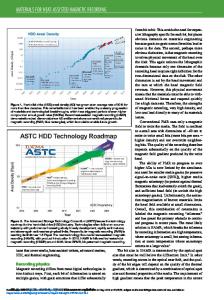Magnetic Recording Materials
- PDF / 6,288,430 Bytes
- 4 Pages / 604.8 x 806.4 pts Page_size
- 22 Downloads / 403 Views
Magnetic Recording Materials •' It was more than a century ago, in 1888, many of the magnetic recorder's later apwhen Oberlin Smith vyrote an article for plications, but even with this interest, The Electrical World, describing his idea for Poulsen could not find financial backers to storing electrical information by means of put the device into large-scale production magnetized particles. Magnetic tapes hâve in Europe. Finally, in 1903, he and several since become one of the most accurate, American backers formed the American convenient ways to store information as diTelegraphone Company to manufacture verse as sound and video signais, controlan improved version of the device. ling impulses for machinery, or data from The sound reproduction, though, was business and scientific apparatus. In fact, inferior to the quality obtainable from the anything that can be converted to an elecphonograph at the time, and was plagued trical signal can be stored magnetically and with distortion and noise. The telelater reproduced. Because magnetic storgraphone never found wide application, age média can be erased and re-used many and Poulsen's Company eventually failed. times over, such materials also hâve a great While more information could be stored économie advantage over other recording on a given space of wire than on any of the methods. other common magnetic-storage materials, the sound reproduction suffered from a poor signal-to-noise ratio and "crosstalk," or interférence from adjacent reInl927J.A.O'NeiUwas corded layers wound together on the same spool. But the development of other mateawarded a U.S. patent rials for magnetic storage alleviated some for his process of drying of thèse problems. a liquid containing In 1927 J.A. O'Neill was awarded a U.S. patent for his process of drying a liquid magnetic particles containing magnetic particles on the surface of a strip of paper, thus creating magon the surface of a netic tape. Fritz Pfleumer in Dresden strip of paper. received a German patent for a similar process a year later. Some very early machines had used a solid métal tape of magnetic material, particularly Vicalloy (a It took a décade after Oberlin Smith's article, however, before anyone put into prac- magnetic stainless steel of 52% cobalt, 11% vanadium, and 37% iron), but the paper or tice a storage System that used magnetic (later) plastic tapes soon proved to be the materials. Danish inventor Valdemar Poulsen created a device that could store most useful form of magnetic recording an electrical signal on a length of magnetic material. steel wire. He applied for a patent in DenTape was most often coated with red iron mark on December 1, 1898, and also reoxide, Fe203, as the magnetic material. ceived a U.S. patent on November 13,1900. Black iron oxide, Fe304, was used, produced a stronger signal but was more diffiPoulsen's electromagnetic recording head hooked up to receive electrical signais cult to erase. In the late 1960s, to meet a from a téléphone transmitter. A moving demand for the slow tape speed and the
Data Loading...











